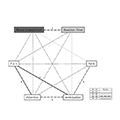Abstract
Brain-computer interfaces (BCIs) have been focused on providing direct communications to the disabled. Recently, BCI researchers have expanded BCI applications to non-medical uses and categorized them as active BCI, reactive BCI, and passive BCI. Neurocinematics, a new application of reactive BCIs, aims to understand viewers’ cognitive and affective responses to movies from neural activity, providing more objective information than traditional subjective self-reports. However, studies on analytical indices for neurocinematics have verified their indices by comparisons with self-reports. To overcome this contradictory issue, we proposed using an independent psychophysical index to evaluate a neural engagement index (NEI). We made use of the secondary task reaction time (STRT), which measures participants’ engagement in a primary task by their reaction time to a secondary task; here, responding to a tactile stimulus was the secondary task and watching a movie trailer was the primary task. NEI was developed as changes in the difference between frontal beta and alpha activity of EEG. We evaluated movie trailers using NEI, STRT, and self-reports and found a significant correlation between STRT and NEI across trailers but no correlation between any of the self-report results and STRT or NEI. Our results suggest that NEI developed for neurocinematics may conform well with more objective psychophysical assessments but not with subjective self-reports.
